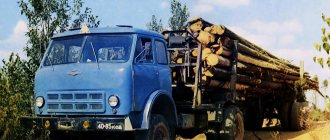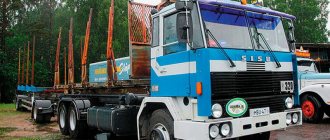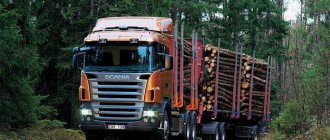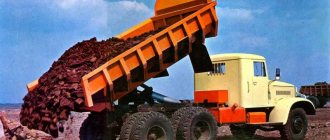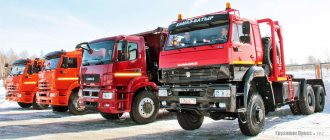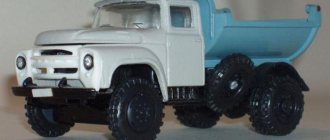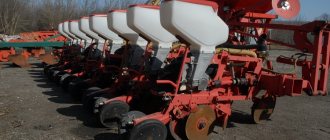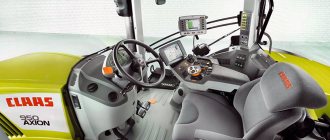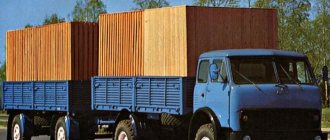In the post-war period in the USSR, industrial development would not have been possible without an increase in the number of freight transport. One of the largest manufacturers of trucks at that time was the Minsk Automobile Plant. In the 60s, this plant began producing completely new trucks, designated MAZ-500. The manufacturer also used this truck to produce a number of special equipment, including vehicles intended for logging work. The trucks used to transport timber received their designation - MAZ-509.
Timber carrier MAZ-509
MAZ-509 was a tractor equipped with a trailer. Timber trucks based on the 500 series of MAZ trucks were produced for a very long time; during production it was modernized twice. The production of MAZ timber trucks began in 1966 with the MAZ-509P model.
MAZ-509P was a trial series with not a very large number of cars produced. Production of this version did not last long - until 1969.
Immediately after the start of production of the MAZ-509P model, the plant’s designers began searching for and eliminating shortcomings in this car. The result of this was the almost parallel production of a slightly improved model - MAZ-509. The production of this model was longer - its mass production began in 1966 and ended in 1978.
The MAZ-509 model was replaced in 1978 by a timber carrier with the designation MAZ-509A. This was the last timber carrier built on the basis of the 500 series of MAZ trucks. The MAZ-509A model was produced until 1990. Photo of timber truck MAZ-509
The outdated fleet required updating
The 500th series was designed to change the minds of Soviet engineers, drivers and mechanics. The designers of the Minsk Automobile Plant proposed to place the engine not in front of the cabin, as was done previously, but to remove it, as it were, “inside” the cabin, or rather, under it. The cabin was supposed to be tilting, which would provide access to engine parts. Among other things, the cabover structure made it possible to increase the working length of the body, which would provide greater load capacity and capacity. Initially, this design caused a lot of controversy, but the fact that this technology had already been successfully mastered abroad provoked the technical commission to accept the changes.
Also, in order to increase the operating power of the cars, it was decided to equip them with a more efficient engine, the development of which just began at the Yaroslavl Motor Plant in mid-1958.
However, testing and testing new technical solutions required time, which MAZ engineers did not have. In this regard, it was decided to use new models of the 200 series as prototypes: 200M and 200P. It was on them that new cabins were successively installed. engines, gearboxes, frames, etc. This solution, on the one hand, helped designers see with their own eyes inaccuracies and shortcomings, and on the other hand, allowed them to continue mass production. Thus, from 1962 - 1965. In parallel with the assembly of MAZ 500 prototypes, the plant carried out small-scale production of intermediate units. In 1965 production of the MAZ 200 was finally discontinued, and a new era associated with the MAZ 500 began.
The series included a dump truck under the symbol 503, a truck tractor under the symbol 504 and a MAZ 509P forestry road train, the trial production of which began on 04/06/1966. Like all cars of the new series, the timber truck was produced in limited “experimental series”, which made it possible to eliminate shortcomings directly on finished cars almost without stopping production.
Design features
As stated, the timber carrier was built on the basis of the MAZ-500, but it had a number of differences. At that time, all MAZ trucks were among the most modern in the USSR, but the timber truck differed quite seriously from the MAZ-500 in terms of transmission.
The power plant of the MAZ-509 did not differ from the 500-series models. This was a completely new power unit YaMZ-236. This engine was 6-cylinder, with a V-shaped cylinder position, and had a water cooling system. Its power was enough to produce both a truck tractor and a timber truck on the basis of a regular MAZ-500 truck.
But the transmission that was used on the MAZ-509 was slightly different than that of other models. The timber carrier was the first car of the Minsk plant, which was equipped with all-wheel drive. In addition, the gearbox for the timber truck was also revised. The MAZ-509 models had a 5-speed, and the gearbox ratios were also different. At first, timber trucks were equipped with a front axle with a planetary gearbox, which was quickly abandoned in favor of a conventional axle design.
Used semi-trailers
To transport wood with this tractor, two trailers were used - GKB-9383 and TMZ-803M. These trailers were biaxial and equipped with a self-pulling mechanism. This mechanism made it possible to fold the trailer trolley and load it onto the tractor. When the cart was not in use and was loaded onto a tractor, the MAZ-509 was two-axle, but when wood transportation was required, the trailer folded out and the timber truck became four-axle, with two drive axles. The use of these spreader trailers made it possible to transport wood 17-27 m long on the MAZ-509.
Second life of the old MAZ - auto-tuning
This machine has already served its purpose on high-impact construction projects of the national economy. Now an old Soviet truck has been turned into a classic American hot rod. Such conversions of old Soviet cars are not uncommon. But trucks as donors are not common.
Although, I remember there was a GAZ, a ZIS, the 130th ZIL (it seems that it was never completed), the 157th, even the UAZ-452 “Loaf”! But definitely no one has ever built a hot rod based on a MAZ!
Yes, initially it was approximately this MAZ 200 series. To be completely precise, it’s not even exactly the same as in the photo, but a rarer “military” all-wheel drive modification. If my memory serves me correctly, it had an index of either 501 or 502 - I’m too lazy to check now.
It was converted into a hot rod (or custom car?) by the famous customizer Yuri Shif. This, by the way, is his first work not with a motorcycle, but with a car.
The project was traditionally given its own name - Mazzy, although Maz Die was also among the working options...
In memory of our ancestors, and as a tribute to the Minsk Automobile Plant, the Mazzy hood is decorated with a metal figurine of a bison. It is completely original; these are the mascots that were installed on Minsk trucks in the late 50s and early 60s.
It all started with the rusty frame of a truck, once purchased for $500. For several years it lay in the backyard of Yuri Shif’s motorcycle workshop. There were thoughts of making “something like that” out of it, but it didn’t go beyond a sketch drawn with a ballpoint pen on some scrap of paper. The car rusted on the street, and the sketch was pinned to the wall among many other similar drawings. But one day, one of the regular customers of the workshop, discussing the design of his next motorcycle, noticed this picture...
- Guys, can you do this? - he asked - Of course we can! - Yuri answered and immediately received a new order. By and large, only the cabin from the MAZ that was rusting in the yard was used. It was restored, its roof was lowered and its wheel arches were widened.
Specifications
Technical characteristics of the MAZ-509 timber truck:
| Characteristics | Indicators | Unit measurements |
| Length (with trailer folded) | mm | 6770 |
| Width | mm | 2600 |
| Height | mm | 2900 |
| Wheelbase | mm | 3950 |
| Clearance | mm | 300 |
| Weight of equipment | kg | 8800 |
| Power point | type | YaMZ-236, diesel, 6-cylinder |
| Working volume | l | 11,15 |
| Power | hp | 200 |
| Transmission | type | mech., 5-speed, |
| Wheel formula (with trailer folded/unfolded) | type | 4x4/8x4 |
| Average fuel consumption | l/100 km | 48 |
| Maximum speed | km/hour | 65 |
| Trailers used | type | GKB-9383, TMZ-803M |
| Max. lifting capacity | T | 21 |
| Max. length of transported wood | m | 27 |
In the video, the MAZ-509 timber truck:
Technical specifications
The MAZ-509 timber carrier was produced from 1966 to 1978.
- Drive - 4x4.
- Diesel engine power - 200 hp.
- Dimensions - 6770x2600x2900 mm.
- Ground clearance - 300 mm.
- Loading capacity - 10 tons.
- The gearbox is five-speed.
- Speed - 65 km/h.
- Turning radius - 11.5.
The MAZ-500 timber truck was produced for the northern regions. The truck is equipped with an insulated cabin and a high-power liquid heater. A pre-heater is installed. A spotlight can be installed on the roof to operate in polar night conditions. This truck is not very popular due to this specificity.
- Drive - 4x2.
- Power - 180 hp
- A diesel engine is installed.
- Dimensions of the car: 6800x2600x2900 mm.
- Ground clearance - 270 mm.
- Loading capacity - 8 tons.
- The gearbox is five-speed.
- Speed - 60 km/h.
- Turning radius - 12.
The MAZ-501 timber carrier is the oldest model, which was manufactured from 1955 to 1966.
The machine is equipped with a cabin with metal upholstery. The tractor is all-wheel drive and is operated with a trailer. The truck is also equipped with turning bunks. Later models do not have a hood.
- Drive - 4x4.
- Power - 120 hp
- The engine is diesel.
- Loading capacity - 15 tons.
- The gearbox is five-speed.
- Speed - 45 km/h.
A more modern timber carrier MAZ-6317 was produced in 1991, and it is still in production. The car's engine has been improved. The model is manufactured in the form of a log carrier or with a trailer. Units and systems have been improved, making it possible to work with different types of logs.
Modifications
The MAZ-509 series of timber trucks consisted of three models, which were slightly different from each other. If we compare the MAZ-509P and MAZ-509 models, they had technical differences.
The experimental model MAZ-509P was equipped with a single-plate clutch and had a front axle with a planetary differential.
But in the MAZ-509 the clutch was replaced with a double-disc one, the axle was changed, the gear ratios of the gearbox and transfer case were changed, which led to an increase in speed and load capacity. But outwardly these two models did not differ from each other; they were equipped with a cabless cab from the MAZ-500.
The differences between the MAZ-509 and MAZ-509A models came down to appearance. The later model MAZ-509A already had a cabin from the MAZ-5335 truck installed. On the technical side, 509 and 509A were no different. Video review of the MAZ-509A timber truck:
Volgoles type timber carrier
In the Soviet Union, from the beginning of the 50s, the implementation of a shipbuilding program began, according to which, among other types of cargo ships, it was planned to serially build timber carriers of various carrying capacity from 1000 to almost 6000 tons. Ships intended for the transportation of timber were built both at domestic and foreign shipyards of the CMEA member countries - the Council for Mutual Economic Assistance. The need to build specialized vessels with a heavy lifting capacity, over 5,000 tons, was caused by the ever-increasing volumes of exports of products from the timber industry of the Soviet Union. As part of the ongoing program, the Gdansk Shipyard (Stocznia Gdańska), located in the Polish city of Gdansk on the Baltic Sea, was chosen as one of the shipyards for the construction of a series of large timber carriers. In 1958, in accordance with the technical specifications issued to the Polish contractor, the Central Design Bureau of the Polish People's Republic developed a project for a large timber carrier, which received the number No. B 514-RT. After consideration and approval of the project by the Foreign Trade Association "Sudoimport" of the USSR, according to its order, the construction of the lead vessel, called "Volgoles", began in 1959 at the Gdansk Shipyard. The ship received its name in honor of the timber carrier of the same name, built in 1932 at the Admiralty plant in the city of Leningrad and which became the lead in a series of large pre-war timber carriers. Based on the name of the vessel, the new series of large timber carriers began to be called the “Volgoles” type. In 1960, the construction of the timber carrier was completed and it became part of the Baltic Shipping Company. According to the architectural and design type, the timber carrier was a single-screw, single-deck, three-island vessel, with a minimum freeboard, with a forecastle, a poop and a mid-position superstructure and engine room, an inclined semi-icebreaking stem and a cruising stern. The vessel had a welded hull and superstructure, with the exception of the shearstrake and deck stringer in the middle part, which were connected to each other using rivets. The hull was assembled using a mixed composition system: deck, bottom and second bottom in the middle part according to the longitudinal system; sides and ends - along the transverse. At the ends of the hull the size of the spacing was 600 mm, and in the rest - 700 mm. The frame frames were installed according to the following scheme: in the area of the cargo holds every four frames, in the engine room - every two or three. The side frame of the hull was reinforced with intermediate frames and side stringers. To reduce the ship's roll, especially when sailing in ballast, bilge keels made of a 300 mm high strip-bulb profile were installed on the hull. The sternpost with rudder post was cast from steel and had an ice protrusion (“ice tooth”) to protect the rudder from damage when sailing in ice. The stem was made according to a mixed design: the lower semi-icebreaking part was cast, the upper surface part had a welded structure. The superstructure with the wheelhouse, living and utility rooms was located in the middle part of the vessel, and it also contained the engine room. This arrangement of the superstructure significantly increased the longitudinal strength of the vessel and made the crew’s accommodation significantly more comfortable, since in the middle part of the vessel the vibration from the propeller is minimal, and what is also important is that pitching has virtually no effect on the crew. A minor drawback of the location of the engine room in the middle part of the vessel is the need to build a tunnel for the propeller shaft in holds No. 3 and No. 4, which led to a reduction in the capacity of each of these holds by approximately 100 m³. It may seem very strange to the modern reader that once upon a time, not so long ago, when designing cargo ships, the concept of “crew habitability” was necessarily taken into account and, in the interests of sailors, they even went to reduce the capacity of the ship. However, everything is very simple, at that time in the Soviet Union, care for people came first, so the superstructures of all Soviet cargo ships were always much larger and more spacious than on ships of Western countries, and the living conditions in them were much more comfortable.
The living quarters were designed for 46 people. All living quarters were equipped with an air conditioning system, which supplied heated air in winter. Steam heating in combination with an air conditioning system was provided in the service and utility rooms. The vessel had a USSR Register class - KM * L1, a timber carrier and an unlimited navigation area. The timber carrier had ice class L1 and could be operated during summer navigation in the Arctic seas of the Soviet Arctic, and in such seas as the White, Baltic, Okhotsk and northern part of Japan, and in the winter months, under icebreaker assistance. The addition of “timber carrier” in the vessel class formula meant that the vessel had a minimum freeboard height in accordance with the timber load line and complied with the requirements of the Code of Safe Practice for Ships Carrying Deck Timber Cargoes. In addition to various timber cargo, the ship was intended to transport general and bulk cargo, including bulk grain. For cargo, the ship had four holds without tweendecks, holds No. 1 and No. 2 were located between the forecastle and the middle superstructure, and holds No. 3 and No. 4 between the superstructure and the poop. The holds of the timber carrier had a traditional shape for that time and therefore they had so-called “pockets” - the space under the deck between the hatch clearance and the side of the ship. There are no “pockets” on ships with straight-walled holds whose hatch dimensions match the hold dimensions. Such ships already existed at that time; for example, in the Soviet Union there were two ships of the so-called “Amsterdam type”, built in 1936 at a shipyard in Holland. However, it should be noted that the transportation of lumber in packages became widespread only in the second half of the 60s, so the presence of “pockets” in the holds of timber carriers of the Volgoles type should not be considered such a big drawback; after all, they were intended not only for transporting timber cargo. A timber carrier of this type “Grodekovo” of the Far Eastern Shipping Company was later converted to transport containers and for many years transported them from the Far Eastern ports of the USSR to the ports of Japan and back. In addition, ships of this project were actively used during the Cuban Missile Crisis. When the ship was fully loaded with timber, for lateral stability, it was necessary to take about 300 tons of water ballast into the bottom ballast tanks. For this reason, ships of this type were classified as ballast timber carriers. In order to make a timber carrier without ballast, it was necessary either to increase its width, or to make inclined sides on it, or to implement both, however, both options led to an increase in the construction cost of the vessel, and the economic effect from a slight increase in the timber carrying capacity did not cover these costs. The country needed a simple and cheap timber carrier and the Volgoles type vessels were just that, and 80 (eighty) units of them were built in two series! Since the ships were intended to navigate in ice, including Arctic ice, a heating system was provided in the ballast tanks to prevent water from freezing in them.
Technical characteristics of the timber carrier:
Gross tonnage – 4638 gross reg. tons Net capacity – 2348 net reg. tons Deadweight: when loaded with timber - 6205 tons, when loaded with grain or other cargo - 5895 tons. Load capacity – 5166 tons. Displacement when loaded with timber - 9530 tons, when loaded with grain or other cargo - 9220 tons. Hold capacity: bale – 7516 m³; grain – 8280 m³; packaged timber – 7516 m³; containers – 66 TEU. Maximum length – 123.88 m. Length between perpendiculars – 115.00 m. Width – 16.70 m. Hull height – 8.45 m. Draft when fully loaded with timber – 7.02 m; with other cargo - 6.82 m. The main engine on the ship was a Sulzer 5SAD-72 (5DKRN72/125) diesel engine, manufactured at a plant in Switzerland in the city of Winterthur. Engine power 4500 e. l. With. (3310 kW). The type of transmission to the propeller shaft is direct. The shaft rotated at a speed of 125 rpm. The engine was controlled directly in the engine room. The shaft rotated a bronze solid-cast four-bladed fixed-pitch propeller with a diameter of 4600 mm, a pitch of 4110 mm, a disk ratio of 0.499, and a weight of 8600 kg. Vessel speed: fully loaded – 14.8 knots; in ballast - 15.4 knots. The ship's fuel reserves - 576 tons and water - 114 tons allowed the ship to sail 10,440 miles without replenishment. For a vessel of this size and purpose, this is more than enough. The steering device consisted of a Hastie electric steering gear and a semi-balanced steering wheel. The anchoring device consisted of an SAV VIII electric windlass, two Hall anchors weighing 3199 kg each and anchor chains of 55 mm caliber, 250 m long for each anchor. Steel covers of the McGregor system were used as hatch covers. All cargo holds were equipped with natural and forced ventilation. The cargo device consisted of eight light cargo booms, with a lifting capacity of 5 tons and an overhang of 6.2 m (with paired operation of the booms, their carrying capacity was reduced to 3 tons); one cargo boom, with a lifting capacity of 15 tons and an overboard reach of 3.6 m, and one heavy lift boom, with a lifting capacity of 40 tons and an overboard reach of 3.6 m. The cargo booms were installed on L-shaped masts, which were installed: the first between the holds No. 1 and No. 2, the second at the aft bulkhead of the superstructure for cargo operations in hold No. 3, and the third at the poop for cargo operations in hold No. 4. The ship was equipped with the most modern navigation instruments and instruments at that time, allowing for safe navigation in any conditions. The timber carrier "Volgoles" worked for the Baltic Shipping Company for 29 years and was sold in 1989. As they say, the ship worked for itself and for its predecessor, the steamship Volgoles, which the Nazis captured on June 22, 1941 in the port of Szczecin and was sunk by Soviet torpedo boats off Kirkenes on August 19, 1944. The first Volgoles worked for the shipping company for only nine years, so for both timber carriers, 38 years of operation is very good from a commercial point of view.
Unfortunately, after the collapse of the great country of the USSR, the new Russia lost the status of not only a Great Maritime Power, but also just a maritime country. Currently, the country has lost its transport independence and is completely dependent on foreign sea carriers. Cargo ships flying the Russian flag carry less than 1.5% of cargo transshipped through our country's seaports. Russia has not had such figures for 300 years, that is, over the past 20 years, in the field of maritime transport the country has been thrown back to pre-Petrine times. Over the past 20 years, not a single seagoing dry cargo ship has been built at the country's shipyards; the only ship was the Ussuriysk dry cargo ship, the construction of which began in the 90s. Well, if there are no ships, then of course there is no continuity in transferring to them the names of ships that are being taken out of service. Let’s hope that after the end of the “time of troubles” in our country, the new government will begin to revive the country’s maritime merchant fleet and again we will see in the ports and seas cargo ships with iconic Russian names that are dear to every Russian person, among which there must necessarily be a motor ship called named after the great Russian river.
Large sea timber carriers of Project B 514-RT, Volgoles type:
| Serial number | Vessel name | Put into operation | MMF Shipping Company |
| B514/01 | "Volgoles" | 09.1960 | BMP |
| B514/02 | "Comiles" | 12.1960 | BMP |
| B514/03 | "Dvinoles" | 12.1960 | BMP |
| B514/04 | "Severoles" | 12.1960 | BMP |
| B514/05 | "Primorles" | 04.1961 | Far Eastern MP |
| B514/06 | "Aldanles" | 05.1961 | Far Eastern MP |
| B514/07 | "Adimiles"; since 1973 - “Captain Beloshapkin” | 06.1961 | Far Eastern MP |
| B514/08 | "Abakanles" | 08.1961 | BMP |
| B514/09 | "Arkhangelskles" | 12.1961 | BMP |
| B514/10 | "Alapaevskles" | 12.1961 | BMP |
| B514/11 | "Alatyrles" | 01.1962 | BMP |
| B514/12 | "Andomales" | 06.1962 | SMP |
| B514/13 | "Angarskles" | 1962 | BMP |
| B514/14 | "Abagurles" | 06.1962 | SMP |
| B514/15 | "Anadyrles" | 06.1962 | Far Eastern MP |
| B514/16 | "Bryanskles" | 09.1962 | BMP |
Author: Captain V.N. Filimonov
